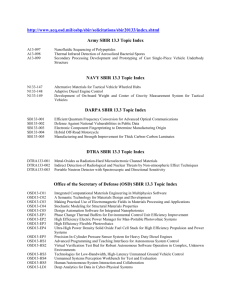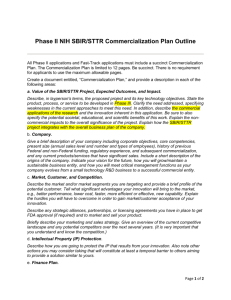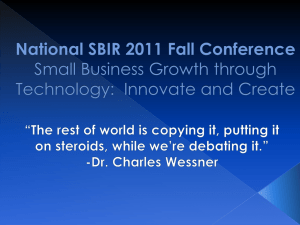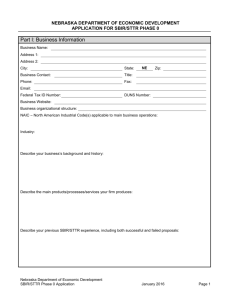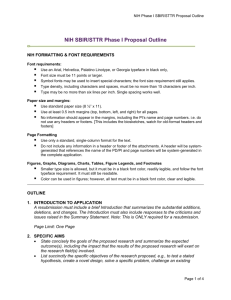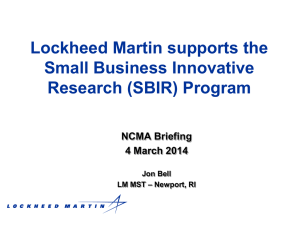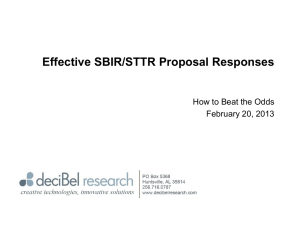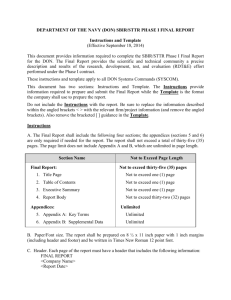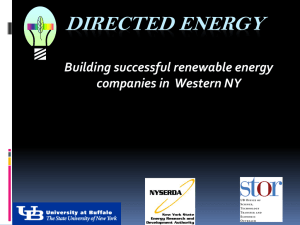Small Business Innovation Research (SBIR)
advertisement
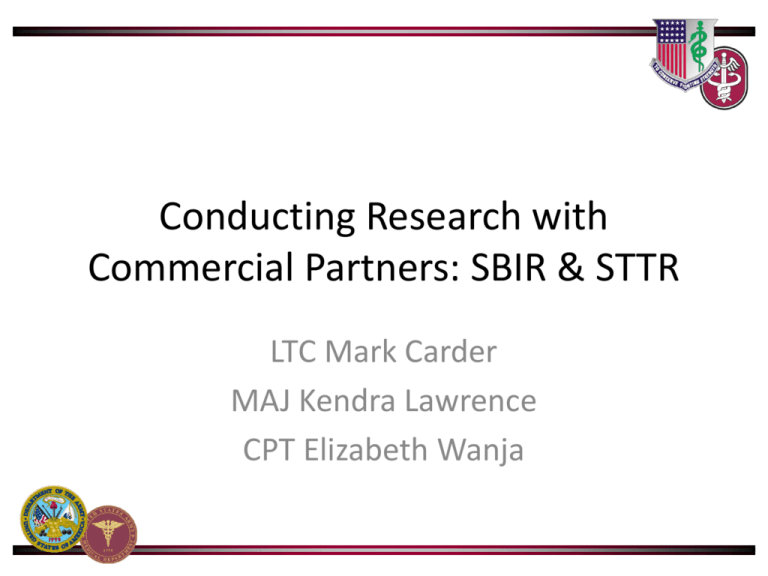
Conducting Research with Commercial Partners: SBIR & STTR LTC Mark Carder MAJ Kendra Lawrence CPT Elizabeth Wanja Disclaimer Material has been reviewed by the Walter Reed Army Institute of Research. There is no objection to its presentation and/or publication. The opinions or assertions contained herein are the private views of the author, and are not to be construed as official, or as reflecting true views of the Department of the Army or the Department of Defense. Research was conducted in compliance with the Animal Welfare Act and other federal statutes and regulations relating to animals and experiments involving animals and adheres to principles stated in the Guide for the Care and Use of Laboratory Animals, NRC Publication, 1996 edition. The Program • The U.S. Small Business Administration (SBA) Office of Technology administers the Small Business Innovation Research (SBIR) Program and the Small Business Technology Transfer (STTR) Program. • Through these two competitive programs, SBA ensures that the nation's small, high-tech, innovative businesses are a significant part of the federal government's research and development efforts. • Eleven federal departments participate in the SBIR program • Five departments participate in the STTR program awarding $2billion to small high-tech businesses. • The U.S National Science Foundation administers the SBIR.GOV site on behalf of the federal government. The DoD SBIR & STTR Programs • The SBIR Program provides up to $850,000 in early-stage R&D funding directly to small technology companies (or individual entrepreneurs who form a company). • The STTR Program provides up to $850,000 in early-stage R&D funding directly to small companies working cooperatively with researchers at universities and other research institutions. SBIR • The DoD SBIR program, funded at approximately $1.14 billion in FY 2008 • 12 participating components: – – – – – – – – – – – – Army Navy Air Force Missile Defense Agency (MDA) Defense Advanced Research Projects Agency (DARPA) Chemical Biological Defense (CBD) Special Operations Command (SOCOM) Defense Threat Reduction Agency (DTRA) National Geospatial-Intelligence Agency (NGA) Defense Logistics Agency (DLA) Defense Microelectronics Activity (DMEA) Office of Secretary of Defense (OSD). The Basics • The Small Business Innovation Research program funds early-stage R&D at small technology companies and is designed to: – – – – stimulate technological innovation increase private sector commercialization of federal R&D increase small business participation in federally funded R&D foster participation by minority and disadvantaged firms in technological innovation • To participate in the SBIR program: – a firm must be a U.S. for-profit small business of 500 or fewer employees – work must be performed in the United States – during Phase I, a minimum of 2/3 of the effort must be performed by the proposing firm; a minimum of 1/2 of the effort in Phase II – the Principal Investigator must spend more than 1/2 of the time employed by the proposing firm The Quick Pic The Small Business Innovation Research (SBIR) and Small Business Technology Transfer Program (STTR) programs allow small, high-tech U.S. businesses (less than 500 employees) and academia the opportunity to provide innovative research and development solutions in response to critical Army needs. By capturing the tremendous and agile talents of the U.S. small business community, the SBIR and STTR Programs benefit the Department of Defense (DoD), the private sector, and our national economy. This portal provides all the information necessary to participate in these programs. -New Army Phase I Proposal Submission Instructions -2010 CPP Companies -QUARTERLY SBIR NEWSLETTER -TECHNICAL ASSISTANCE Last Updated: January 11, 2010 -SECURITY/PRIVACY NOTICE -508 ACCESSIBILITY -DISCLAIMER OF ENDORSEMENT AND LIABILITY Topic Submission • The SGS is the starting point for SBIR topic generation • Army participates in three DoD SBIR Solicitations each year • Specific areas of interest are provided based on input from individual research programs • Depending on Technology Requirements and Capability Gaps • Request for topic concept is sent out from MRMC in a tasking memo Topic Submission • How the process works • Topic concepts are submitted • Concept consists of a topic title and brief description (20-30 words) • HQ MRMC reviews topic concepts • Approved topic concepts are developed into full SBIR topics • HQ MRMC reviews full topics Topic Submission • Approved topics are reviewed by the Technology Area Chief (TAC) • TAC approved topics are forwarded to DDR&E • DDR&E approved topics are posted online for proposal submission The Hi-Z Experience • R & D oriented thermoelectric business • Staff of 17 engineers, physicists, metallurgists and technicians • Designs, develops, manufactures, and markets bulk material Thermoelectric Modules and Generator systems, ranging from milliwatt size to multiple kilowatt size in power output • Self powered heamatophagous trap – Phase I – Phase II – Demo units delivered and tested on the field The Hi-Z Experience Proprietary Device Bottom part Hi-Z CO2 Generator prototype Proprietary Device Top Part The Hi-Z Experience • Trap bulky, difficult to operate-requires at least 2 people • Not possible to keep the stove flame on during windy/rainy days • Poor combustion-CO2 pipe constantly filled with soot • Trap caught fire on several occasions • Very low trap catches (≤ 5 mosquitoes) on the 3 days trap was operational Current WRAIR Entomology SBIRs • • • • • • Field-deployable CO2 generator Improved residual insecticide matrix Improved insecticide-treated bed net Wearable spatial repellent device New uniform treatment methods Dipsticks for detection of • Dengue and Rift valley fever viruses • West Nile and Chikungunya viruses • Sand fly fever virus and Leishmania parasites CO2 Generator Solicitation •Solicitation requirements • Light weight, rugged, and field-portable • Generate CO2 from small quantities of non-hazardous starting materials • CO2 must contain no impurities and able to attract vectors • Flow rates comparable to or better than 200mL/minute • Generator should be safe to operate unattended for ≥ 12 hours • Generation method must be reliable, reproducible with non-hazardous waste CO2 Generator Solicitation Cont… • All proposals consisted of hydrocarbon and acid-base based projects • Two companies awarded Phase I and also Phase II – One hydrocarbon based, one acid-base based project • Hydrocarbon based –CUBE Technology • Acid-base- TDA Research Inc CO2 Generator prototypes Proprietary Device TDA Research Inc CO2 Generator prototype CO2 Generator Prototypes Cont…. Proprietary Device CUBE Technology CO2 Generator prototype CO2 Generator Experience • Both companies’ CO2 generator prototypes strictly follow solicitation requirement • Demonstrate exemplary work • Performance is consistently of high quality • Work plans to achieve project goals are well-organized and executed • Progress made to date has met and exceeded expectations • Development and testing is ahead of schedule – CUBE prototype will be ready for field testing during Spring 2010 – TDA generator prototype tested in the field during Summer 2009 CO2 Generator Experience 4.5 LS Mean Mosquito Count 4.0 3.5 3.0 2.5 2.0 1.5 1.0 0.5 0.0 MTA BG-BG CDC- BG CO2 Negative Dry Ice Lure Lure Sachet Control CRADA Octenol Acid-base Trap Types Adjusted Mean Mosquito Counts Across Trap Type
